Scarlet Cord in the Bible symbolizes salvation and promise, revealing deep insights into faith's role in redemption and modern relevance.
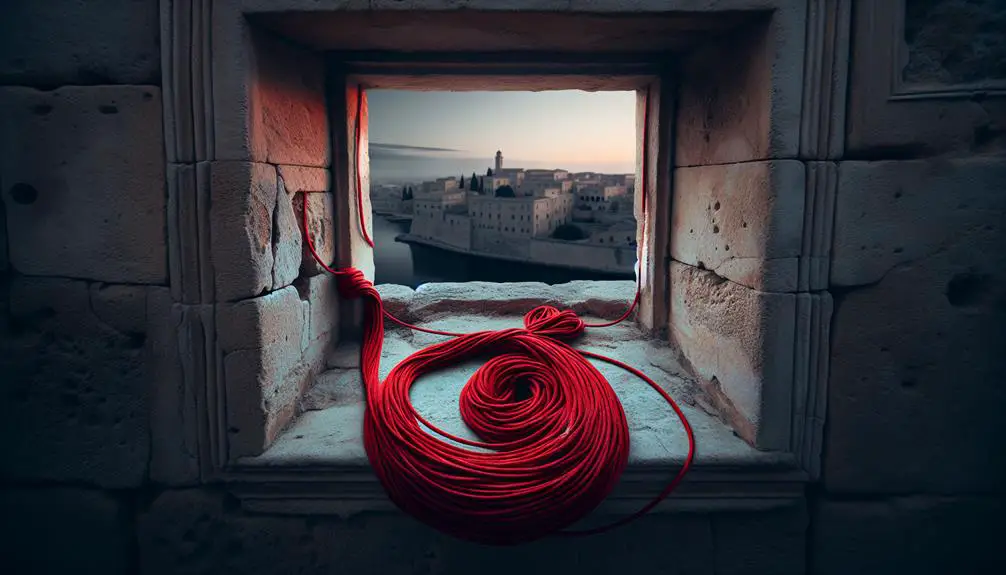
Scarlet Cord in the Bible
The scarlet cord, referenced in the biblical narrative of Rahab and the fall of Jericho, serves as a multifaceted symbol intertwining themes of salvation, covenant, and divine promise. Through the lens of historical context, this seemingly simple object is elevated from a mere tool of survival to a profound emblem of faith and redemption.
As we explore the theological significance and the transcultural symbolism of the scarlet cord, intriguing questions arise regarding its interpretation and relevance in contemporary discourse. What insights can this ancient symbol offer to modern readers seeking understanding in a complex world? The answers may surprise and challenge traditional perspectives.
Key Takeaways
- The scarlet cord symbolizes faith, redemption, and divine grace in Rahab's story from the fall of Jericho.
- It represents God's inclusivity, saving those with faith regardless of their past.
- Across cultures, the scarlet cord resonates with universal themes of protection, renewal, and the complexities of faith and redemption.
- Modern interpretations challenge traditional views, highlighting the scarlet cord's enduring relevance and multifaceted symbolism.
Historical Context
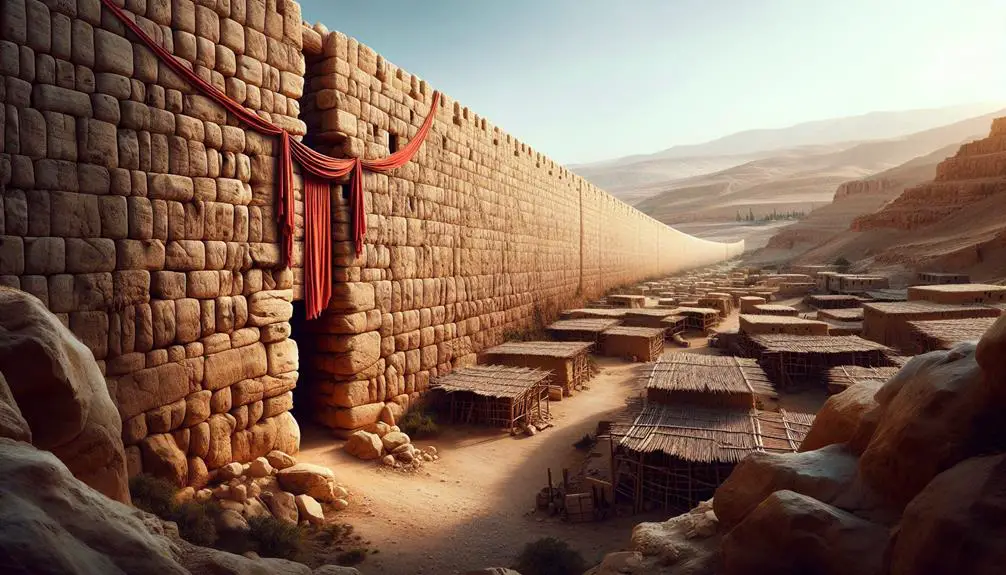
The scarlet cord, a symbol rich in biblical significance, finds its origins in the ancient city of Jericho, woven into the narrative of Rahab's alliance with Israelite spies during their covert mission. This thread, both literal and metaphorical, ties together themes of faith, redemption, and the collapse of barriers, set against the backdrop of Jericho's fall. As one of the oldest and most fortified cities of that era, Jericho represented a formidable obstacle to the Israelites' conquest of Canaan. Its eventual fall, precipitated by miraculous means, marked a turning point in biblical history, symbolizing divine intervention and the fulfillment of a covenant.
The narrative intricately ties Rahab's act of ancient hospitality towards the spies with the broader theme of salvation and deliverance. This act of sheltering the spies under her roof, at great personal risk, underscores the prevailing customs of ancient hospitality, wherein the protection and care of guests were considered sacred duties, transcending societal and ethical boundaries. Rahab's strategic decision to aid these foreign operatives, therefore, speaks volumes about the complex interplay of faith, fear, and allegiance in times of upheaval.
Analyzing this episode through the lens of ancient warfare and societal norms provides a nuanced understanding of the significance of Rahab's actions and the symbolic weight of the scarlet cord. It was not merely a sign for physical salvation from the impending destruction but also emblematic of a deeper spiritual deliverance, weaving Rahab into the fabric of Israel's communal memory as a harbinger of hope and a testament to the power of faith and redemption.
Rahab's Lifeline
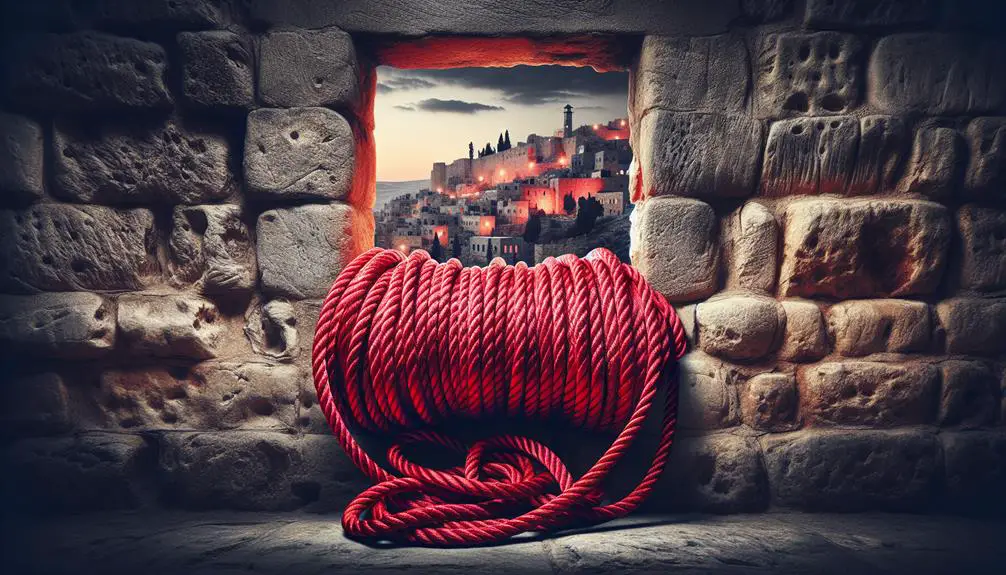
In the biblical narrative of Jericho's conquest, Rahab's lifeline—a scarlet cord—serves as a potent symbol of survival and divine promise, intricately connecting her fate to the Israelites' victory. This narrative is rich with themes of urban espionage and moral ambiguity, as Rahab, a Canaanite prostitute, harbors Israelite spies under the condition that her family be spared in the impending siege. The scarlet cord she is instructed to tie in her window becomes not just a physical marker, but a metaphorical link between her act of faith and the broader divine narrative unfolding with the Israelites.
Element |
Symbolism |
Emotional Impact |
|---|---|---|
Scarlet Cord |
Survival & Promise |
Hope amidst despair |
Rahab |
Moral Ambiguity |
Complexity of faith |
Spies |
Urban Espionage |
Tension and intrigue |
Jericho's Fall |
Divine Intervention |
Awe and fear |
Rahab's Family |
Mercy & Protection |
Relief and gratitude |
This tableau reflects the intricate dance between divine providence and human agency, highlighting the unexpected ways in which salvation can manifest. Rahab's story, punctuated by her use of the scarlet cord, challenges traditional notions of righteousness, suggesting that faith and redemption are accessible even within the context of deception and moral complexity. This account, deeply embedded in the fabric of the conquest narrative, not only underscores the strategic importance of urban espionage but also invites reflection on the nature of divine selection and the inclusivity of redemption. Rahab's lifeline, thus, symbolizes a bridge between disparate worlds, embodying a profound narrative of hope, transformation, and divine fulfillment.
Theological Significance
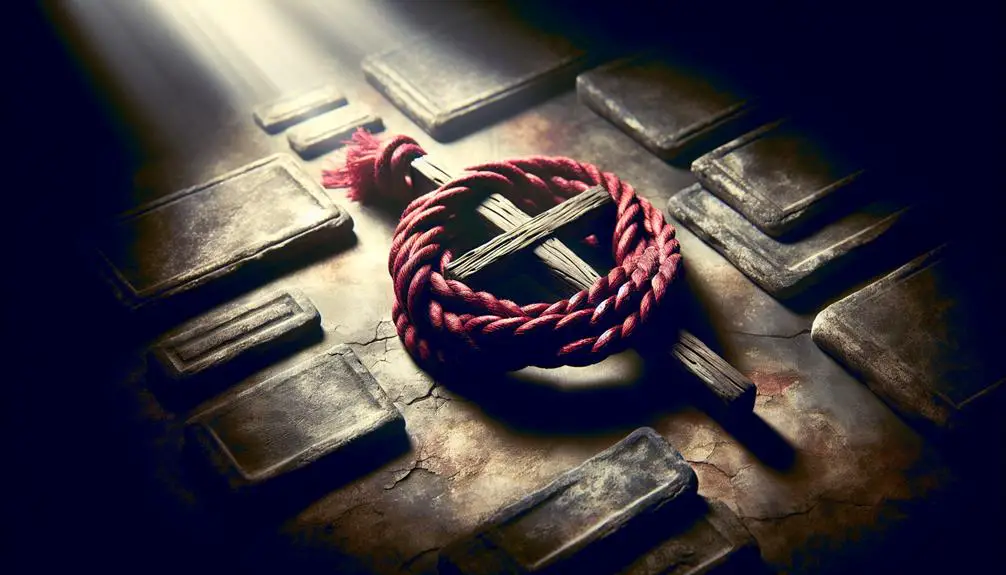
Exploring the theological significance of the scarlet cord in the biblical narrative reveals deep layers of redemption, covenant, and divine grace that transcend mere historical events. This vivid symbol, tied to Rahab's window as a sign for Israelite spies, encapsulates a multifaceted representation of divine protection and covenantal promise. The scarlet cord, by its color and purpose, becomes a tangible manifestation of God's saving grace, extending beyond Rahab and her household to encompass a broader theological canvas.
In the Hebrew scriptures, color often bears rich symbolic meaning, with scarlet frequently associated with sin, sacrifice, and salvation. Within this context, the scarlet cord not only marked Rahab's home for physical salvation from the destruction of Jericho but also symbolized a deeper, spiritual redemption. It signified her faith in the God of Israel and her inclusion into the covenantal community, transcending her previous identity and societal status. This act of divine protection, then, is not merely a historical footnote but a theological archetype, illustrating God's willingness to save and incorporate those who demonstrate faith, regardless of their background or past transgressions.
Furthermore, the scarlet cord's role as a covenant representation is pivotal. It serves as a physical sign of the agreement between Rahab and the spies, foreshadowing the New Covenant in Christ, where the blood of the Lamb marks believers for salvation. The theological significance of the scarlet cord, therefore, lies in its ability to convey themes of redemption, divine protection, and the inclusivity of God's covenant, offering a profound narrative of grace that resonates through the ages.
Symbolism Across Cultures
Building upon the rich theological significance of the scarlet cord within the biblical narrative, it is imperative to examine its symbolism across various cultures to fully appreciate its multifaceted dimensions. The exploration of color symbolism and cultural rituals around the globe reveals that the color red, and by extension the scarlet cord, embodies a spectrum of meanings extending far beyond its initial biblical context.
In many Eastern cultures, red is synonymous with good fortune, prosperity, and protection. It prominently features in cultural rituals, such as weddings and New Year celebrations, symbolizing joy, luck, and warding off evil spirits. This contrasts with its biblical connotation of protection and promise, yet underscores a universal appreciation for the color's powerful symbolism.
In indigenous American traditions, red is often associated with the earth, life, and vitality. The use of red ochre in ceremonies and rites of passage signifies the connection between life and death, embodying regeneration and the cyclical nature of existence. This perspective enriches the understanding of the scarlet cord, expanding its symbolism to encompass not only protection but also the broader themes of life, death, and rebirth.
Furthermore, in Western art and literature, the color red has historically denoted passion, power, and danger. While these themes diverge from the protective symbolism in the biblical narrative, they highlight the complexity and depth of color symbolism in human culture.
Through examining the scarlet cord's symbolism across cultures, it becomes evident that its significance is deeply woven into the fabric of human history and spirituality, transcending geographical and cultural boundaries to resonate with universal themes of protection, life, and renewal.
Modern Interpretations

Delving into contemporary perspectives, the interpretation of the scarlet cord has evolved, reflecting shifts in societal values and technological advancements that influence modern spirituality and cultural expressions. The scarlet cord's narrative, originating from biblical times as a symbol of protection and covenant, now faces interpretive challenges in a pluralistic society. These challenges are not only theological in nature but also encompass issues of cultural appropriation, as diverse groups adopt and adapt the symbol for various purposes, often detached from its original context.
Modern interpretations of the scarlet cord navigate a complex landscape where ancient religious symbols are recontextualized within new-age spiritual movements, art, literature, and digital media. This reappropriation raises questions about the authenticity and integrity of religious symbols in contemporary culture. Scholars and theologians argue that while the scarlet cord's adaptability demonstrates its enduring relevance, it also exposes the tension between maintaining a symbol's sacredness and its inevitable evolution within a globalized society.
Furthermore, the digital era has expanded the reach of religious symbols, enabling instantaneous sharing across cultures but also facilitating cultural appropriation. The scarlet cord, like many religious symbols, is subject to diverse interpretations that can sometimes obscure its original biblical significance. This phenomenon underscores the need for a nuanced understanding of the historical and cultural context of religious symbols to navigate their modern interpretations responsibly.
Frequently Asked Questions
How Has the Imagery of the Scarlet Cord Been Utilized in Contemporary Art and Literature Outside of Religious Contexts?
The imagery of the scarlet cord has transcended its original religious context, finding resonance in contemporary art and literature. In modern fashion, it has been symbolically incorporated as a motif that conveys themes of connectivity and salvation.
In cinematic symbolism, it often represents a lifeline or a path of fate intertwining characters' destinies. Such adaptations demonstrate the enduring power and versatility of the scarlet cord as a symbol in various contemporary cultural expressions.
Are There Any Known Ancient Rituals or Practices Among the Israelites or Neighboring Cultures That Specifically Involved a Scarlet Cord or Similar Symbol?
In examining ancient rituals and practices, one finds that the use of cords, particularly those dyed in vivid colors, holds significant symbolic weight.
For instance, within certain Near Eastern cultures, a scarlet cord might symbolize protection or a covenant.
The choice of color and cord materials was often deeply intentional, reflecting societal values or beliefs.
This analysis underscores the importance of color symbolism and material culture in understanding ancient ceremonial practices.
How Do Different Jewish and Christian Denominations Today View or Incorporate the Story and Symbol of the Scarlet Cord in Their Teachings and Rituals?
Today, various Jewish and Christian denominations interpret and integrate the symbol of the scarlet cord with nuanced perspectives. This emblem, rich in historical and theological layers, often embodies themes of redemption, protection, and covenant within religious teachings.
While specific cord rituals are not universally practiced, the scarlet symbolism frequently emerges in liturgical contexts, sermons, and educational materials, illustrating the enduring influence of this symbol across different faith communities and their interpretative traditions.
Can the Concept of the Scarlet Cord Be Found in Any Non-Abrahamic Religious Traditions or Mythologies With Similar or Contrasting Meanings?
The inquiry into the presence of red symbolism within non-Abrahamic religious traditions or mythologies uncovers intriguing cultural parallels.
An analytical exploration reveals that red, often associated with protection, sacrifice, and covenant, manifests in various global narratives with comparable or divergent significances.
This scholarly examination underlines the universality and diversity of red symbolism, underscoring its multifaceted roles across different cultural contexts, thereby enriching our understanding of its symbolic spectrum beyond a singular religious narrative.
What Are the Psychological Impacts or Interpretations of the Scarlet Cord Imagery on Individuals' Faith and Spirituality, According to Modern Psychological Studies?
Modern psychological studies indicate that color psychology significantly influences individuals' interpretations of symbolic imagery, affecting their faith and spirituality. For instance, red, associated with energy and passion, can evoke strong emotional responses.
Symbolic interpretation of similarly vivid imagery can deepen spiritual connections or provoke introspection. However, specific studies on the scarlet cord's psychological impact are scant, suggesting a fertile area for future research into how such symbols shape spiritual and psychological landscapes.
Conclusion
In conclusion, the narrative of the scarlet cord in the Bible transcends mere historical recounting, evolving into a profound symbol of salvation, hope, and divine promise.
Just as a lighthouse provides guidance and safety to ships amidst treacherous seas, the scarlet cord served as a beacon of deliverance for Rahab and her family.
This story, rich in theological significance and cultural symbolism, continues to inspire and resonate across generations, reflecting the enduring power of faith and redemption in the human experience.


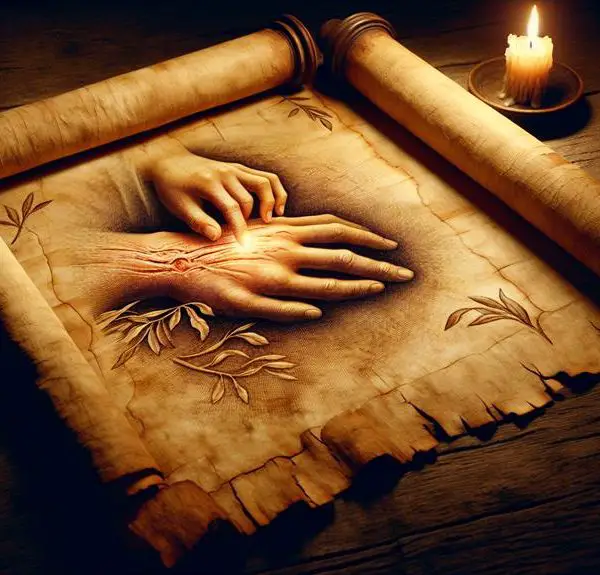
Sign up